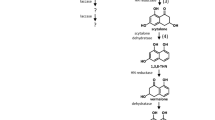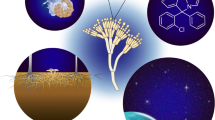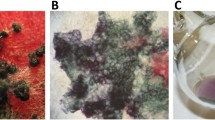Abstract
Melanin is a complex polymer, which is widely distributed in nature, and is known as an important virulence factor in opportunistic and pathogenic fungi. In this study, three melanin mutants of Fonsecaea monophora from a case of chromoblastomycosis were generated from a parent strain that lacked hyphal morphology but was meristematic instead. Two albino mutants, one of which (CBS 125187) produced secreted melanin and another (CBS 125149) lacked melanin, grew faster than a mutant with cell-wall-associated and secreted melanin (CBS 125188) and than the meristematic parent strain (CBS 122845) (P < 0.05). The albino strains were also more sensitive to low pH, high UV radiation, and oxidative stress (P < 0.05). However, susceptibility testing against eight antifungal agents showed no statistical difference (P > 0.05). The discovery of three melanin mutants of a single meristematic mutant provided an alternative way to study the role of cell-wall-associated and secreted melanins in the pathogenesis of black fungi.






Similar content being viewed by others
References
Nosanchuk JD, Casadevall A. The contribution of melanin to microbial pathogenesis. Cell Microbiol. 2003;5(4):203–23.
Morris-Jones R, Gomez BL, Diez S, Uran M, Morris-Jones SD, Casadevall A, et al. Synthesis of melanin pigment by Candida albicans in vitro and during infection. Infect Immun. 2005;73(9):6147–50. doi:10.1128/IAI.73.9.6147-6150.2005.
Chaskes S, Tyndall RL. Pigment production by Cryptococcus neoformans and other Cryptococcus species from aminophenols and diaminobenzenes. J Clin Microbiol. 1978;7(2):146–52.
Gomez BL, Nosanchuk JD, Diez S, Youngchim S, Aisen P, Cano LE, et al. Detection of melanin-like pigments in the dimorphic fungal pathogen Paracoccidioides brasiliensis in vitro and during infection. Infect Immun. 2001;69(9):5760–7.
Romero-Martinez R, Wheeler M, Guerrero-Plata A, Rico G, Torres-Guerrero H. Biosynthesis and functions of melanin in Sporothrix schenckii. Infect Immun. 2000;68(6):3696–703.
Nosanchuk JD, Gomez BL, Youngchim S, Diez S, Aisen P, Zancope-Oliveira RM, et al. Histoplasma capsulatum synthesizes melanin-like pigments in vitro and during mammalian infection. Infect Immun. 2002;70(9):5124–31.
Nosanchuk JD, van Duin D, Mandal P, Aisen P, Legendre AM, Casadevall A. Blastomyces dermatitidis produces melanin in vitro and during infection. FEMS Microbiol Lett. 2004;239(1):187–93. doi:10.1016/j.femsle.2004.08.040.
Tsai HF, Fujii I, Watanabe A, Wheeler MH, Chang YC, Yasuoka Y, et al. Pentaketide melanin biosynthesis in Aspergillus fumigatus requires chain-length shortening of a heptaketide precursor. J Biol Chem. 2001;276(31):29292–8. doi:10.1074/jbc.M101998200.
Farbiarz SR, de Carvalho TU, Alviano C, de Souza W. Inhibitory effect of melanin on the interaction of Fonsecaea pedrosoi with mammalian cells in vitro. J Med Vet Mycol. 1992;30(4):265–73.
Alviano CS, Farbiarz SR, De Souza W, Angluster J, Travassos LR. Characterization of Fonsecaea pedrosoi melanin. J Gen Microbiol. 1991;137(4):837–44.
Alviano DS, Franzen AJ, Travassos LR, Holandino C, Rozental S, Ejzemberg R, et al. Melanin from Fonsecaea pedrosoi induces production of human antifungal antibodies and enhances the antimicrobial efficacy of phagocytes. Infect Immun. 2004;72(1):229–37.
Franzen AJ, de Souza W, Farina M, Alviano CS, Rozental S. Morphometric and densitometric study of the biogenesis of electron-dense granules in Fonsecaea pedrosoi. FEMS Microbiol Lett. 1999;173(2):395–402.
Franzen AJ, Cunha MM, Batista EJ, Seabra SH, De Souza W, Rozental S. Effects of tricyclazole (5-methyl-1, 2, 4-triazol[3, 4] benzothiazole), a specific DHN-melanin inhibitor, on the morphology of Fonsecaea pedrosoi conidia and sclerotic cells. Microsc Res Tech. 2006;69(9):729–37. doi:10.1002/jemt.20344.
Cunha MM, Franzen AJ, Alviano DS, Zanardi E, Alviano CS, De Souza W, et al. Inhibition of melanin synthesis pathway by tricyclazole increases susceptibility of Fonsecaea pedrosoi against mouse macrophages. Microsc Res Tech. 2005;68(6):377–84. doi:10.1002/jemt.20260.
Santos AL, Palmeira VF, Rozental S, Kneipp LF, Nimrichter L, Alviano DS, et al. Biology and pathogenesis of Fonsecaea pedrosoi, the major etiologic agent of chromoblastomycosis. FEMS Microbiol Rev. 2007;31(5):570–91. doi:10.1111/j.1574-6976.2007.00077.x.
Nosanchuk JD, Rosas AL, Casadevall A. The antibody response to fungal melanin in mice. J Immunol. 1998;160(12):6026–31.
Rosas AL, Nosanchuk JD, Feldmesser M, Cox GM, McDade HC, Casadevall A. Synthesis of polymerized melanin by Cryptococcus neoformans in infected rodents. Infect Immun. 2000;68(5):2845–53.
Alviano CS, Farbiarz SR, Travassos LR, Angluster J, de Souza W. Effect of environmental factors on Fonsecaea pedrosoi morphogenesis with emphasis on sclerotic cells induced by propranolol. Mycopathologia. 1992;119(1):17–23.
Polak A, Dixon DM. Loss of melanin in Wangiella dermatitidis does not result in greater susceptibility to antifungal agents. Antimicrob Agents Chemother. 1989;33(9):1639–40.
van de Sande WW, de Kat J, Coppens J, Ahmed AO, Fahal A, Verbrugh H, et al. Melanin biosynthesis in Madurella mycetomatis and its effect on susceptibility to itraconazole and ketoconazole. Microbes Infect. 2007;9(9):1114–23. doi:10.1016/j.micinf.2007.05.015.
Xi L, Lu C, Sun J, Li X, Liu H, Zhang J, et al. Chromoblastomycosis caused by a meristematic mutant of Fonsecaea monophora. Med Mycol. 2009;47(1):77–80. doi:10.1080/13693780802322588.
Najafzadeh MJ, Sun J, Vicente V, Xi L, van den Ende AH, de Hoog GS. Fonsecaea nubica sp. nov, a new agent of human chromoblastomycosis revealed using molecular data. Med Mycol. 2010. doi:10.3109/13693780903503081.
Witkin EM. Radiation-induced mutations and their repair. Science. 1966;152(727):1345–53.
Kawamura C, Tsujimoto T, Tsuge T. Targeted disruption of a melanin biosynthesis gene affects conidial development and UV tolerance in the Japanese pear pathotype of Alternaria alternata. Mol Plant Microbe Interact. 1999;12(1):59–63. doi:10.1094/MPMI.1999.12.1.59.
Ruiz-Diez B, Martinez-Suarez JV. Isolation, characterization, and antifungal susceptibility of melanin-deficient mutants of Scedosporium prolificans. Curr Microbiol. 2003;46(3):228–32. doi:10.1007/s00284-002-3858-7.
Schmaler-Ripcke J, Sugareva V, Gebhardt P, Winkler R, Kniemeyer O, Heinekamp T, et al. Production of pyomelanin, a second type of melanin, via the tyrosine degradation pathway in Aspergillus fumigatus. Appl Environ Microbiol. 2009;75(2):493–503. doi:10.1128/AEM.02077-08.
Wang Y, Aisen P, Casadevall A. Cryptococcus neoformans melanin and virulence: mechanism of action. Infect Immun. 1995;63(8):3131–6.
Langfelder K, Streibel M, Jahn B, Haase G, Brakhage AA. Biosynthesis of fungal melanins and their importance for human pathogenic fungi. Fungal Genet Biol. 2003;38(2):143–58.
Jacobson ES. Pathogenic roles for fungal melanins. Clin Microbiol Rev. 2000;13(4):708–17.
Taborda CP, da Silva MB, Nosanchuk JD, Travassos LR. Melanin as a virulence factor of Paracoccidioides brasiliensis and other dimorphic pathogenic fungi: a minireview. Mycopathologia. 2008;165(4–5):331–9.
Rozental S, Alviano CS, de Souza W. Fine structure and cytochemical study of the interaction between Fonsecaea pedrosoi and rat polymorphonuclear leukocyte. J Med Vet Mycol. 1996;34(5):323–30.
Cunha MM, Franzen AJ, Seabra SH, Herbst MH, Vugman NV, Borba LP, et al. Melanin in Fonsecaea pedrosoi: a trap for oxidative radicals. BMC Microbiol. 2010;10:80. doi:10.1186/1471-2180-10-80.
Howard RJ, Valent B. Breaking and entering: host penetration by the fungal rice blast pathogen Magnaporthe grisea. Annu Rev Microbiol. 1996;50:491–512. doi:10.1146/annurev.micro.50.1.491.
Dixon DM, Migliozzi J, Cooper CR Jr, Solis O, Breslin B, Szaniszlo PJ. Melanized and non-melanized multicellular form mutants of Wangiella dermatitidis in mice: mortality and histopathology studies. Mycoses. 1992;35(1–2):17–21.
Fothergill AW. Identification of dematiaceous fungi and their role in human disease. Clin Infect Dis. 1996;22(Suppl 2):S179–84.
Acknowledgments
This work was supported by the Research Fund for the Doctoral Program of Higher Education of China (No. 20100171110068).
Author information
Authors and Affiliations
Corresponding author
Rights and permissions
About this article
Cite this article
Sun, J., Zhang, J., Najafzadeh, M.J. et al. Melanization of a Meristematic Mutant of Fonsecaea monophora Increases Tolerance to Stress Factors While no Effects on Antifungal Susceptibility. Mycopathologia 172, 373–380 (2011). https://doi.org/10.1007/s11046-011-9439-1
Received:
Accepted:
Published:
Issue Date:
DOI: https://doi.org/10.1007/s11046-011-9439-1




